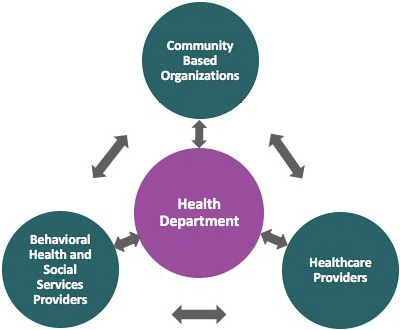About THRIVE
THRIVE: Targeted Highly-Effective Interventions to Reverse the HIV Epidemic
Overview
In 2015, 39,513 new HIV infections were diagnosed in the United States. Gay, bisexual, and other men who have sex with men (MSM) were most heavily affected by HIV infection, and black and Hispanic MSM comprised 67% of all new diagnoses among MSM. To address this high disease burden among MSM of color, health departments will implement culturally competent HIV prevention are care interventions to reduce HIV acquisition and transmission, and to improve outcomes along the HIV continuum of care. These include antiretroviral (ARV) medications that can be used for HIV preeexposure prophylaxis (PrEP) as a daily medication taken by persons at substantial risk for HIV acquisition, or by persons for HIV nonocupational postexpsoure prophylaxis (nPEP) after a potential exposure. The daily use of PrEP has been demonstrated to reduce the risk of HIV acquisition by greater than 90% among sexually active MSM when taken daily. MSM of color will also benefit from prevention services such as routine HIV testing using strategies to detect acute infection, PrEP adherence support, routine screening for sexually transmitted diseases (STDs), and evidence-based risk reduction interventions. ARV treatment with the goal of viral suppression among persons living with HIV (PLWH) has been demonstrated to significantly reduce the risk of transmission to uninfected sexual partners and to improve health outcomes of infected individuals, and interventions and strategies will be implemented to link, retain, and re-engage PLWH in care and to support their adherence to ARV treatment.
Purpose
THRIVE supports state and local health department demonstration projects to develop community collaboratives that provide comprehensive HIV prevention and care services for MSM of color. Each health department leads a collaborative that includes funded community-based organizations (CBOs) and other unfunded partners such as health care providers and behavioral health and social services providers in their jurisdictions (Figure 1). The collaborative models developed in THRIVE will be designed and implemented to be sustainable beyond the end of the project period.
Model for THRIVE Community Collaboratives

Collaboration to Provide Comprehensive HIV Prevention and Care Services for MSM of Color
Each health department grantee must fund local CBOs using at least 25% of its award to provide comprehensive HIV prevention and care services and behavioral health and social services for MSM of color. The health department will ensure that all THRIVE services are provided by including unfunded partners in the collaborative.
- Page last reviewed: April 5, 2017
- Page last updated: April 5, 2017
- Content source: Division of HIV/AIDS Prevention, National Center for HIV/AIDS, Viral Hepatitis, STD, and TB Prevention, Centers for Disease Control and Prevention


 ShareCompartir
ShareCompartir